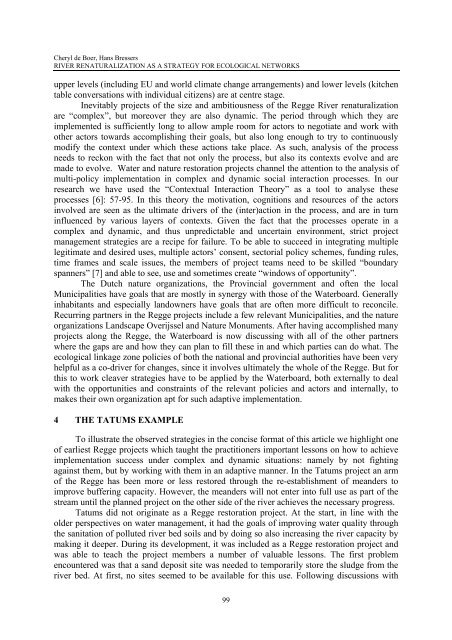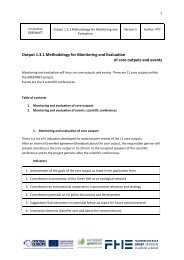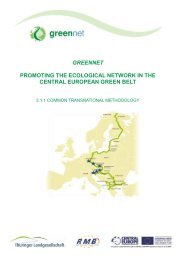The Green Belt as a European Ecological Network strengths and gaps
The Green Belt as a European Ecological Network strengths and gaps
The Green Belt as a European Ecological Network strengths and gaps
Create successful ePaper yourself
Turn your PDF publications into a flip-book with our unique Google optimized e-Paper software.
Cheryl de Boer, Hans Bressers<br />
RIVER RENATURALIZATION AS A STRATEGY FOR ECOLOGICAL NETWORKS<br />
upper levels (including EU <strong>and</strong> world climate change arrangements) <strong>and</strong> lower levels (kitchen<br />
table conversations with individual citizens) are at centre stage.<br />
Inevitably projects of the size <strong>and</strong> ambitiousness of the Regge River renaturalization<br />
are “complex”, but moreover they are also dynamic. <strong>The</strong> period through which they are<br />
implemented is sufficiently long to allow ample room for actors to negotiate <strong>and</strong> work with<br />
other actors towards accomplishing their goals, but also long enough to try to continuously<br />
modify the context under which these actions take place. As such, analysis of the process<br />
needs to reckon with the fact that not only the process, but also its contexts evolve <strong>and</strong> are<br />
made to evolve. Water <strong>and</strong> nature restoration projects channel the attention to the analysis of<br />
multi-policy implementation in complex <strong>and</strong> dynamic social interaction processes. In our<br />
research we have used the “Contextual Interaction <strong>The</strong>ory” <strong>as</strong> a tool to analyse these<br />
processes [6]: 57-95. In this theory the motivation, cognitions <strong>and</strong> resources of the actors<br />
involved are seen <strong>as</strong> the ultimate drivers of the (inter)action in the process, <strong>and</strong> are in turn<br />
influenced by various layers of contexts. Given the fact that the processes operate in a<br />
complex <strong>and</strong> dynamic, <strong>and</strong> thus unpredictable <strong>and</strong> uncertain environment, strict project<br />
management strategies are a recipe for failure. To be able to succeed in integrating multiple<br />
legitimate <strong>and</strong> desired uses, multiple actors’ consent, sectorial policy schemes, funding rules,<br />
time frames <strong>and</strong> scale issues, the members of project teams need to be skilled “boundary<br />
spanners” [7] <strong>and</strong> able to see, use <strong>and</strong> sometimes create “windows of opportunity”.<br />
<strong>The</strong> Dutch nature organizations, the Provincial government <strong>and</strong> often the local<br />
Municipalities have goals that are mostly in synergy with those of the Waterboard. Generally<br />
inhabitants <strong>and</strong> especially l<strong>and</strong>owners have goals that are often more difficult to reconcile.<br />
Recurring partners in the Regge projects include a few relevant Municipalities, <strong>and</strong> the nature<br />
organizations L<strong>and</strong>scape Overijssel <strong>and</strong> Nature Monuments. After having accomplished many<br />
projects along the Regge, the Waterboard is now discussing with all of the other partners<br />
where the <strong>gaps</strong> are <strong>and</strong> how they can plan to fill these in <strong>and</strong> which parties can do what. <strong>The</strong><br />
ecological linkage zone policies of both the national <strong>and</strong> provincial authorities have been very<br />
helpful <strong>as</strong> a co-driver for changes, since it involves ultimately the whole of the Regge. But for<br />
this to work cleaver strategies have to be applied by the Waterboard, both externally to deal<br />
with the opportunities <strong>and</strong> constraints of the relevant policies <strong>and</strong> actors <strong>and</strong> internally, to<br />
makes their own organization apt for such adaptive implementation.<br />
4 THE TATUMS EXAMPLE<br />
To illustrate the observed strategies in the concise format of this article we highlight one<br />
of earliest Regge projects which taught the practitioners important lessons on how to achieve<br />
implementation success under complex <strong>and</strong> dynamic situations: namely by not fighting<br />
against them, but by working with them in an adaptive manner. In the Tatums project an arm<br />
of the Regge h<strong>as</strong> been more or less restored through the re-establishment of me<strong>and</strong>ers to<br />
improve buffering capacity. However, the me<strong>and</strong>ers will not enter into full use <strong>as</strong> part of the<br />
stream until the planned project on the other side of the river achieves the necessary progress.<br />
Tatums did not originate <strong>as</strong> a Regge restoration project. At the start, in line with the<br />
older perspectives on water management, it had the goals of improving water quality through<br />
the sanitation of polluted river bed soils <strong>and</strong> by doing so also incre<strong>as</strong>ing the river capacity by<br />
making it deeper. During its development, it w<strong>as</strong> included <strong>as</strong> a Regge restoration project <strong>and</strong><br />
w<strong>as</strong> able to teach the project members a number of valuable lessons. <strong>The</strong> first problem<br />
encountered w<strong>as</strong> that a s<strong>and</strong> deposit site w<strong>as</strong> needed to temporarily store the sludge from the<br />
river bed. At first, no sites seemed to be available for this use. Following discussions with<br />
99




